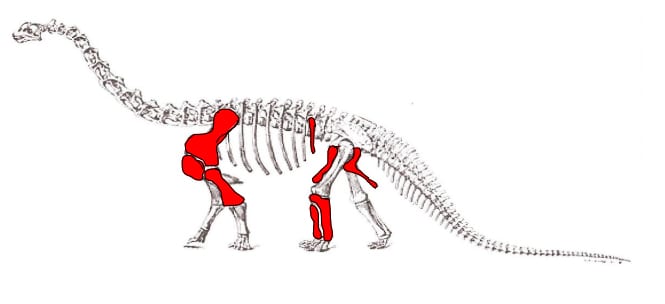A Dinosaur Bone Bed in Utah
A Dinosaur Bone Bed in Utah
Wow, what a trip so far. I was again going digging with the crew from the Burpee Museum of Natural History from Rockford Illinois. This was my second trip with these seekers of the past, last year I accompanied the team to the badlands of Montana see the Hell Creek Formation and dig dinosaurs.
The flight out was great, all flights from Michigan were on time but — for the first time in 30 years if you can believe it, my bags did not arrive with me.
I think I know why. In my suitcase was a backpack, steel toed boots stuffed with socks, my tool roll complete with dental picks, trowel, chisels etc. I assume they x rayed the suitcase saw the stuff and took it for inspection, and placed it on the next flight which was 2 hours later. So far so …OK
Flying into Salt Lake City was like a dream. We crossed over the Wasatch mountain range (5/ 24/08) there was still lots of snow on the mountain peaks and the valleys were a beautiful green. The clouds were jamming up on the side of the mountain range and were puffy like a sea of cotton. We dropped out of the sky and landed without a hitch. Standing outside looking in all directions all I could see on the horizon was snow capped mountains. They themselves were beautiful, but one could see the violent and tumultuous past of the earth. The mountains were young, the slopes severe, the peaks jagged and you could see the layers of the earth violently thrust up at angles showing the power of the earth to change the landscape. This is a geologists dream.
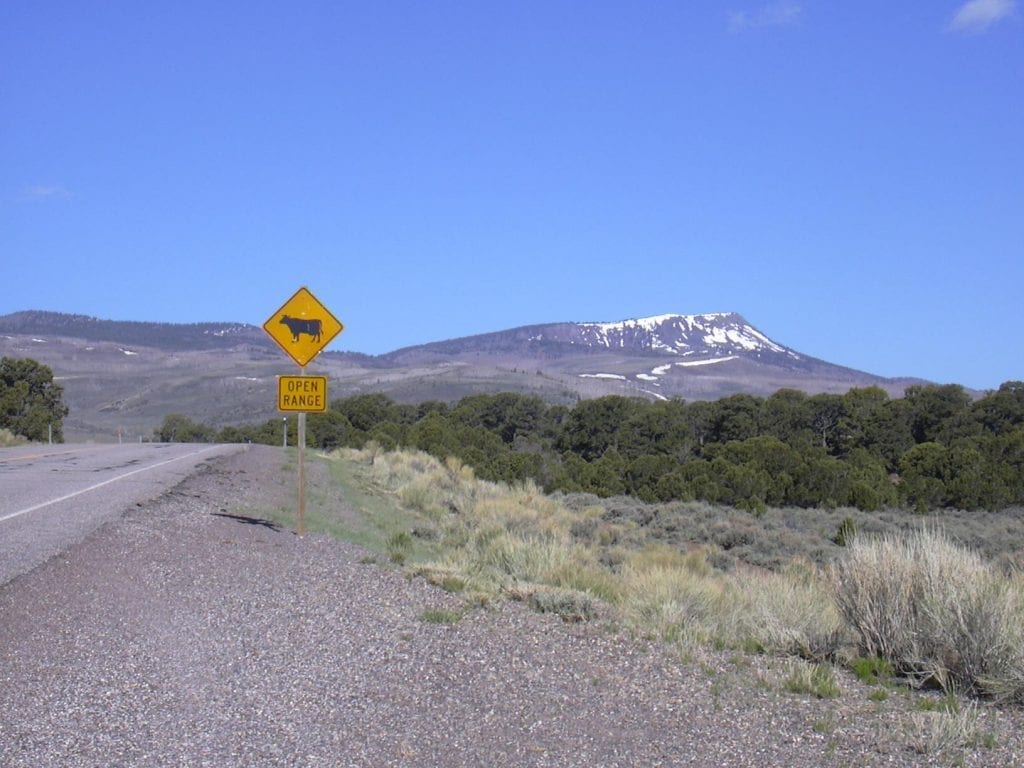
A view of one of the snow-capped mountains in May.
I stopped in Provo for the night and will make it in the last 187 miles to the dig site tomorrow.
Day 1 actually started Sunday. I got up at 6 am which is my usual, packed up and drove down highway 6 towards Green River. About ½ way through the pass in the Wasatch I started driving back uphill. At the top was soldier summit. It began to snow. I kept on going because I wanted to get to Hanksville and see what’s up. Continuing the drive down was – understated absolutely fabulous. The colors of the surrounding mountains and plateaus were stunning. I cannot describe nor will pictures do it justice. It must be seen to be believed. As I turned onto route 24 for my final leg of the trip to Hanksville, I passed through the San Rafael Desert. Yup – a really dry desert. It was but a brief glimpse into where I would be going.
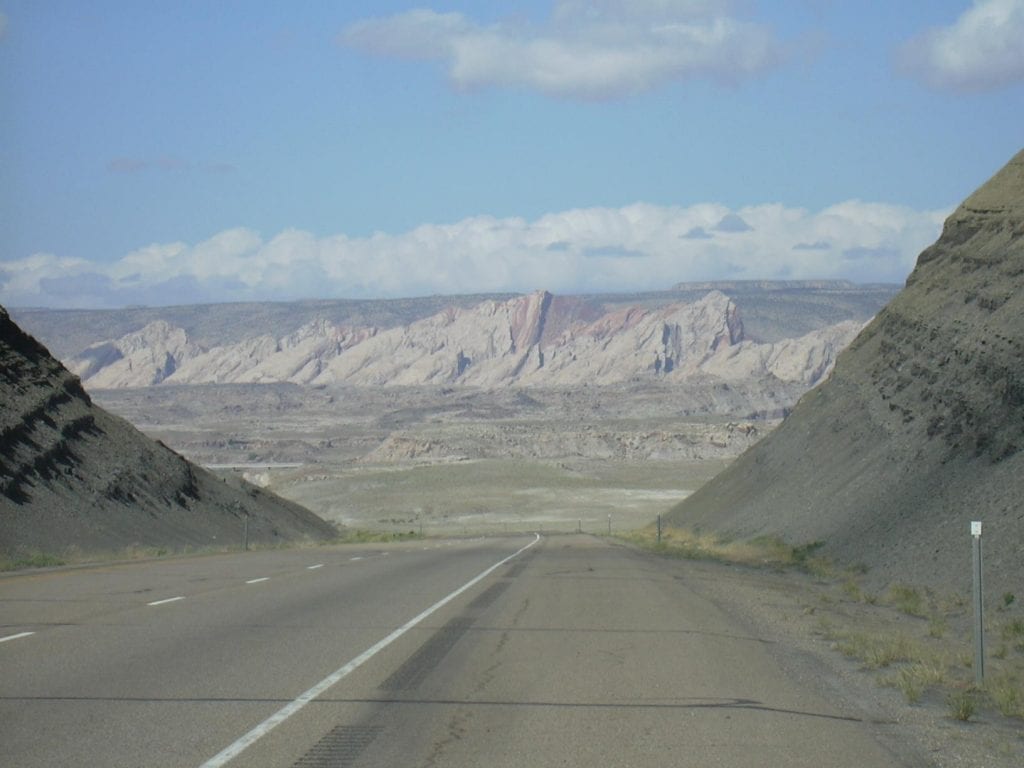
Driving through the desert, sandstone mountains thrust up by the forces of the earth.
Upon arrival at the Whispering Sands Motel I went to the office – closed on Sunday’s of course, but the keys were taped to the door. The room was very- very nice, I like paleontology like this. Hanksville is an extremely small town. 1 bar, 3 restaurants, 2 gas stations, 2 rock shops, and not very many homes. The town hall doubles as the medical clinic that is open only 1 – 4 pm Tuesdays – that’s it. In short – not very large only about 200 people.
Just after I got my stuff unloaded, here came Scott and Mike, Director of exhibits and curator for the Museum. We said our hi’s and I helped them unload some stuff and we talked. They were going into the field for “a while” so I asked if I could come with them and maybe even remove overburden. One of the other guys there chuckled – no he laughed out load. There isn’t any he said.
I jumped in the van with Mike and we drove a few miles down the road, then turned off and drove 10 miles through badlands. They weren’t even badlands, they were desert. The colors again were beyond belief. There were brilliant reds and magentas, purple, cream colors white, black, brown and even places where the sediment was green and blue. NO vegetation for most of the trip. The landscape looked like the surface of Mars the photos beamed back by the rover. Red hills and dirt, boulders exposed and windblown, and guess what ???? NASA actually has a Mars station set up in that area. They are testing a habitat complete with greenhouse. They host a Rover competition in which they invite colleges, universities and others to build Mars rovers and compete in this terrain for the best rover.
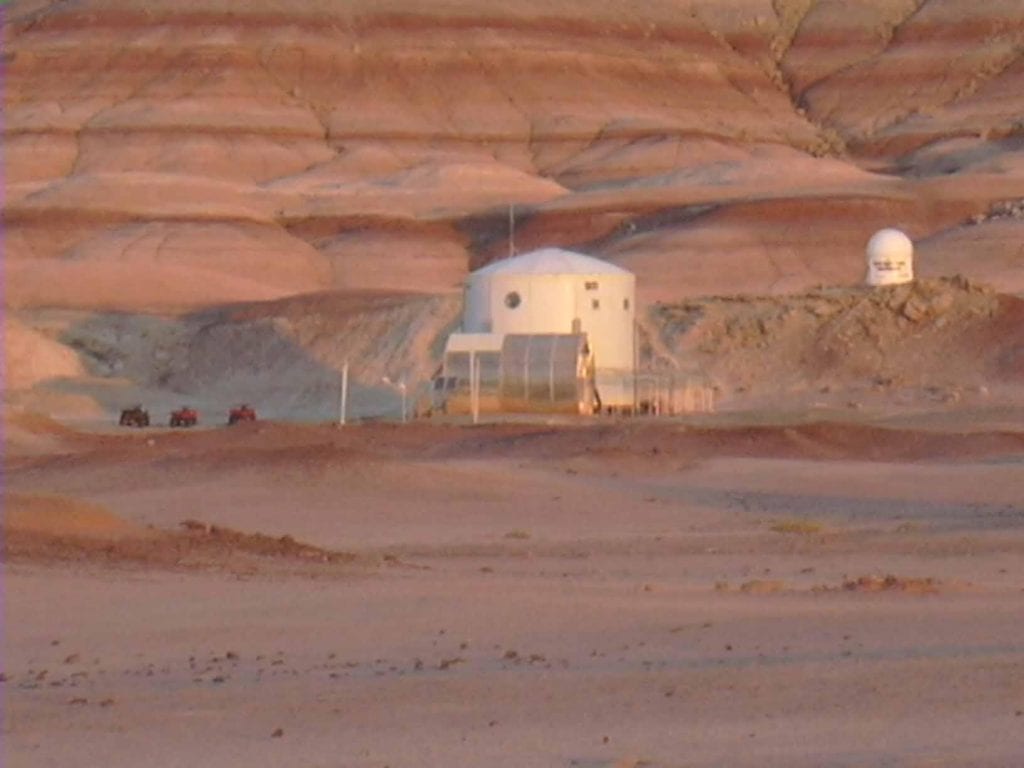
Mars research station and observatory.
OK enough of my love affair with the sights – except for one thing
I have had the honor and privilege of traveling around this country, seeing sights that most people can only dream of. I have seen much of this beautiful land of ours. It is humbling to see. It drives home the fact that we must protect our land, we must protect our earth. We may use and enjoy it but we must protect it. As long as it has been around the earth, is still a fragile thing. We are caught up in our day-to-day lives, but we must protect our earth. As you will see, I will be touching dinosaur bones that haven’t seen the light of day for 147 million years. If the world’s largest and one of the most successful forms of life on earth can die off, can we be far behind.
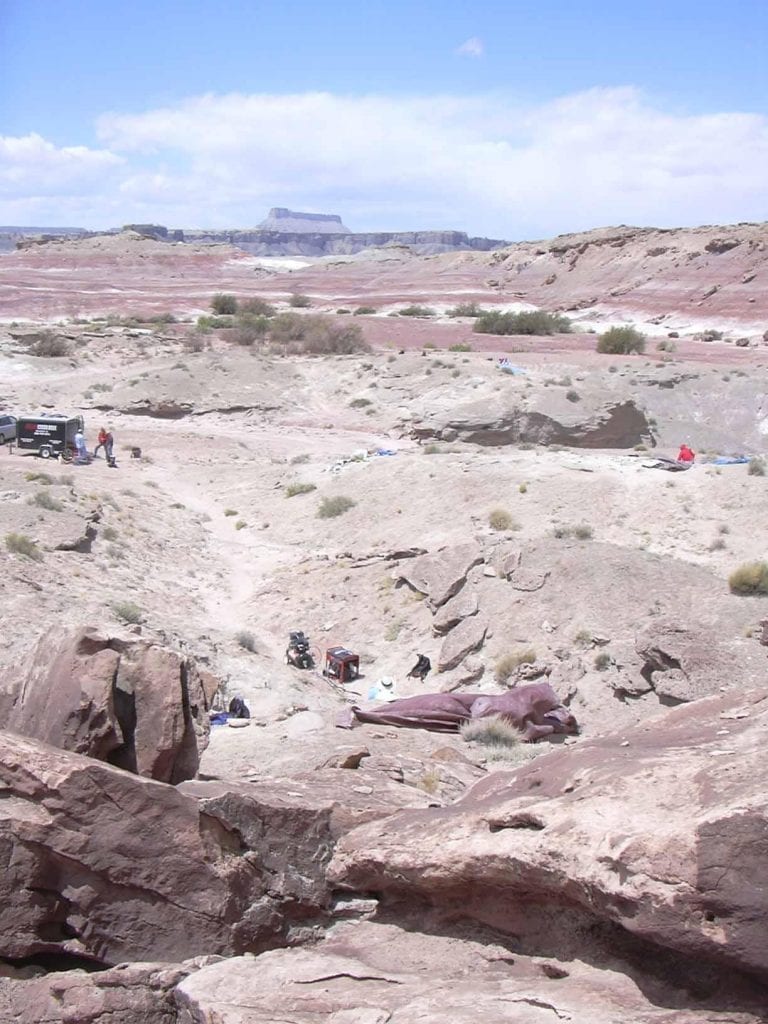
Cow Dung Reservoir
We got to the site, a colorful place called Cow Dung Reservoir, after a bone crushing and kidney busting ride. First thing was to tour the site. Already there had been a crew working for a week and there were exposed bones everywhere. Mostly there were bones of large sauropods. Femurs, vertebra, ribs, tibias and more. It was almost beyond belief.
The sediment was very telling. This was once a river. One look at the sediment told us that. There were water worn rocks and pebbles in varying layers. It was the bottom of a river and these were point bars within the river. The pebble layers were intermixed with sandy layers. Some were easy to get through and some were a hard conglomerate. But the big thing is that this was a river deposition. NO DOUBT. Walking around the large sandstone and conglomerate outcroppings we could see bone weathering out. The Vertebra – verts – were in beautiful cross section, lovely, but much was missing due to erosion and — rock hounds— but there were bones.
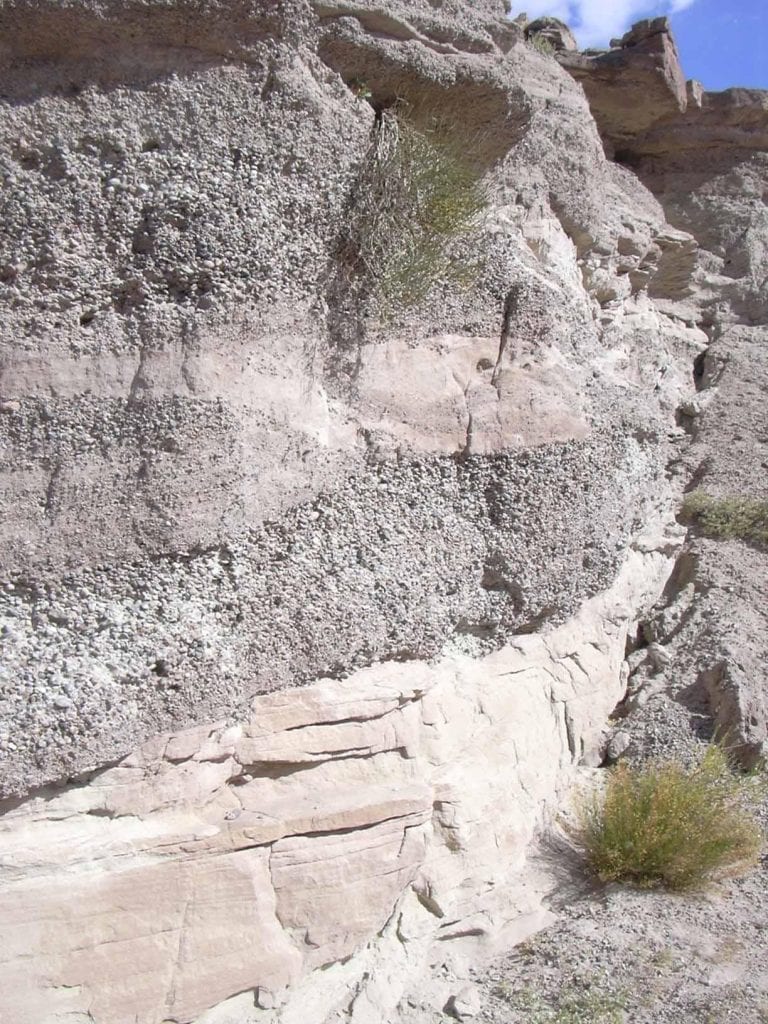
Crews were working all over the site and bones, large bones were being excavated. This was a rich site.
I decided to work in an area near one of the already rich and exposed sites. I tell people this all the time. You don’t just walk around and decide –
I WILL DIG HERE AND FIND DINOSAUR BONES
But in this case, I had a feeling – well it was logical, I was in basically the same horizon, the same sediment about 20 feet away from a nice bone bed and several feet higher, chances were pretty good I’d find some, and find some I did.
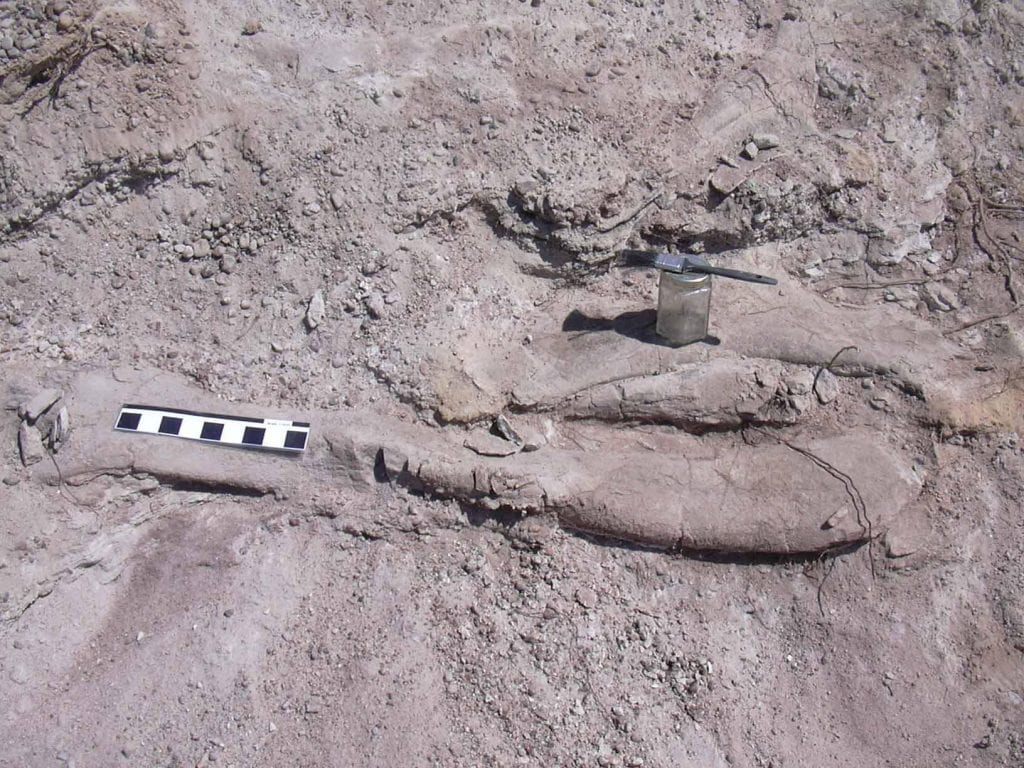
Tibia (with scale) and Pubis (with jar and brush) found on the first day.
I began by slowly and carefully removing the sediment from the top of the site. There were fairly good size pebbles and dirt. Again, the river rock is telling us what this environment was like. I used a broom at first then my paintbrush and within about 2 minutes I discovered the proximal end of a long bone, it was a tibia of a sauropod, a long neck dinosaur. It was about 3 feet long and 6 inches wide. But before I fully exposed that bone, I uncovered another, a pubis, part of the hip structure of a sauropod. Then another pubis and another bone, probably the fibula and a small caudal vertebra, a great find. After working for quite a while removing overburden from the little dig site, I as a bit tired and decided to walk around and see what else was being discovered. As I walked around at the bottom of the little hill, a friend from a previous dig pulled up to the site. It was Frank from NYC. We smiled shook hands, it was old home week. We had been up to our elbows in the badlands of Montana together. We renewed our friendship and toured the site together. Boy he was as excited as I was as we toured the site. I proudly showed him my site and we began to discuss our plan of attack for the nest day. Before I left that day, 7pm, I saw a scorpion, several lizards a huge chunk of petrified wood and tons of dinosaur bones.
When we got back to Hanksville, Frank and met up at the Red rock café for dinner to catch up. Pretty good day – and I wasn’t due to start till tomorrow — BONUS.
Day 2 I was up at a little before 6 am, so I could type this. Off to Blondi’s for breakfast. It is a local restaurant right across from our hotel. The team slowly meandered across the parking lot and road and sat down to eat. Today there will be a meeting for the entire team to get them acquainted with each other and the site. We left the hotel conference room, the main town hall, and part time medical clinic – open Tuesdays only from 1 to and piled into vehicles for the ½ hour trip to the dig site. Once we arrived everyone piled out and Scott, the team leader took everyone around to see what I had seen the day before so Alan – another digger, Frand and I began our plan. We started to sweep the top of the hill but the wind had started to pick up. We did uncover one bone right away, but the blowing sand made it hard to keep working.
When we arrived at the site the crew began to remove the tarps protecting the bones. The temperature was wonderful, the sun was out and it was only around 60 degrees. It should have been great digging weather. The only problem today was the wind. It began to blow hard. My dig sit was situated high on a sandy knoll. The sand began to blow into my eyes, across the dig site. The more I brushed the bones the more sand fell on to the bones. It became nearly impossible to work. I began removing dirt and pebbles from around the bones in preparation to jacket, roll and remove them, but I was tougher. The river conglomerate was nearly as hard as concrete in some places – I would come to find out to
my dismay – harder than concrete in others.
After a few hours of work I walked over to a cliff that had evidence of burrows believed to be mammal. With Alan, who actually is the director of the museum, I walked over to the burrow site, climbed out on to a cliff face and pulled the bottom chamber out, it really does look like a colony of Jurassic ground mammals had been making burrows. We will go back tomorrow to jacket the best ones so they can be removed and studied, but I pulled two off the side and gave them to Alan so they could be x rayed to see if the mammals were in there. Updates on this later and a link will appear here xxxx when we know
Some really great news, one of the first time diggers Mel, went over to the side of the hill and started brushing the dirt away with a trowel and he found bone – 5 bones actually just beneath the surface, as it was getting late we tarped the site and will get to back to digging later, great bones though.
There is some life here in the desert. A Western Blue Tailed Skink went running across the ground – towards me. No problem I stayed as still as I could. In short order he crawled on my hand sat there a while and jumped onto my lap. Before I could get someone to take a picture of this frisky little guy, he jumped off and went merrily on his way – no doubt looking for a shady place to rest. Boy I wish I had some shade.
We got back had dinner – I went to the Red Rock Cafe again with Frank – the other restaurants in town are burger and sandwich shops also great food, but I wanted a sit down restaurant.
Day 3 What a beautiful day, breakfast is at 7:30 but it is 6 am and the sky is a spectacular blue – not a cloud to be seen. Temps today should be in the 70’s and best of all – no wind. As I walk across the parking lot the air smells clean and fresh it should there is little to no pollution here just the magnificence of nature. Across the valley I see the snow capped Henry Mountains. On the other side a grand plateau. My door is open and the occasional car does go by. The Whispering Sands Motel is just south of town.
Well enough of that, you want to read about dinosaurs don’t you.
Well, after cleaning off the bones I had already found previously, just brushing them off and applying Vynac – a concoction of plastic beads dissolved in acetone to help preserve the bones I moved to a new area to dig. The Vynac is a good protectant. The problem with bones is that they are very brittle and prone to deterioration immediately upon exposure. The Vynac brushed on helps. It is brushed or dripped on and soaks into the pores. The acetone quickly evaporates leaving the plastic behind, strengthening and protecting the bone.
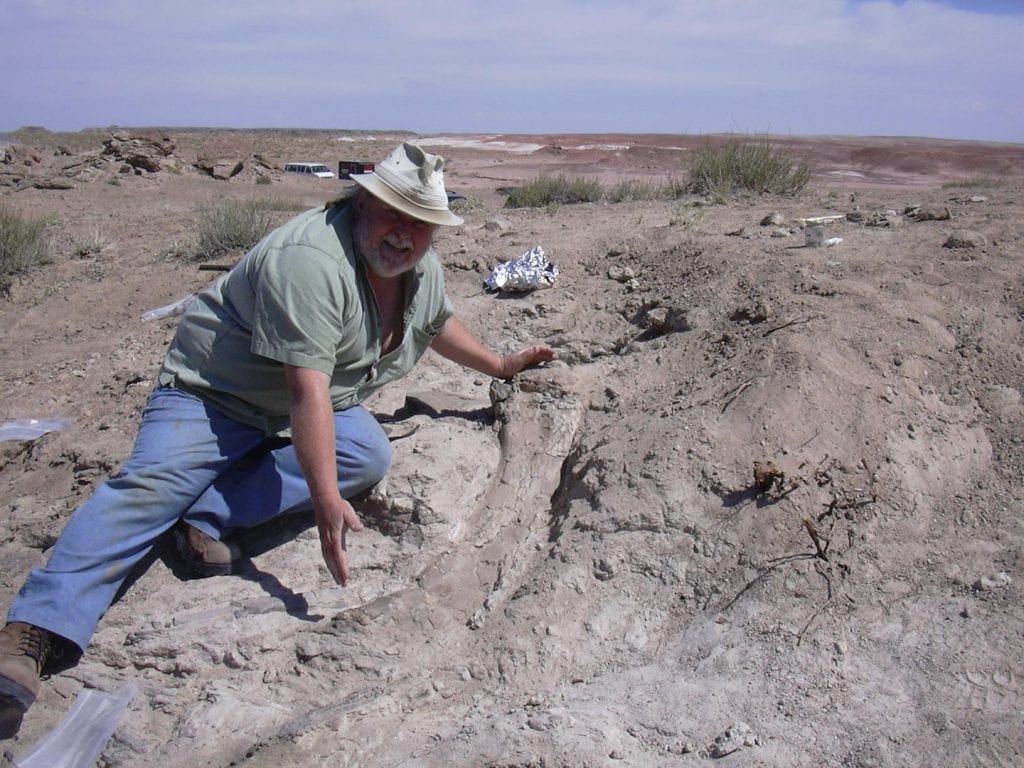
So on to more bones. There was one place where we swept yesterday where there was some float. Float is bone that has weathered out of the ground. I used my small paint brush, brushing away dirt and a small awl to pick away rounded pebbles and bits of soft sandstone and I uncovered what seemed to be a scapula. I gently swept dirt away from the bone. It was a good size about 11 inches wide and almost 2 feet long. As I continued to sweep dirt and pebbles away, much to my amazement there was another scapula. Same size same shape oriented in the exact opposite position. This was cool. To find the right and left scapula together was great. Well not being one to stop digging I swept away dirt and rock and found a corticoid about 4 inches away. The corticoid is a bone that is analogous to our sternum. OK this is cool, I have an possibly associated shoulder girdle.
Well, I kept going and going and soon I found the end of another bone. Following it down deep into hard sandstone, I had exposed a humerus. We are not sure exactly, we have to get it back to the lab to make sure. But hat was not going to be an easy task.
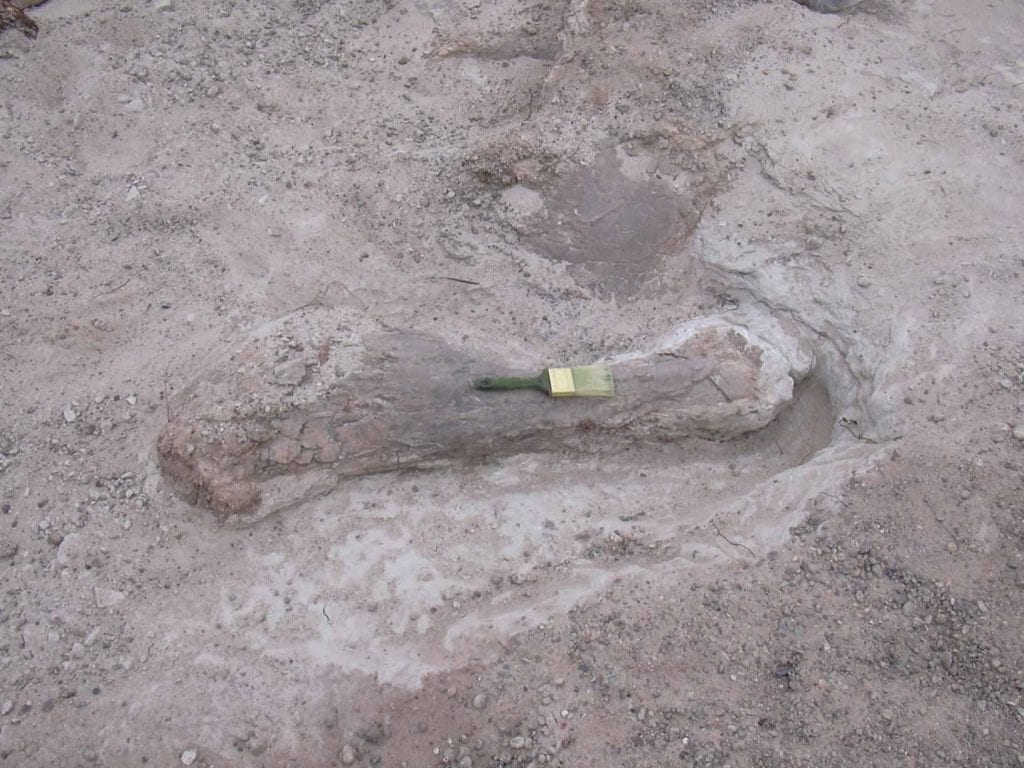
Humerus – arm bone of the Camerasaurus.
Day 4 Last few days were pretty good to say the least. In 3 days of digging I had discovered two pubis bones, which are part of the hip structure, a tibia with a fibula underneath and a small caudal vertebra, from the tip of a tail. Then two scapulas, a short distance away a corticoid and a humerus.
But I was soon to pay a high price for all these bones. The wind 20 -25 miles an hour began to blow. Sitting exposed on the top of the hill exposed us to the sand blast effect of the Utah desert. Those without glasses had a tough time digging. I turned my back to the wind, but the sand just blew around my back and still into my eyes. Some diggers put on handkerchiefs to help fight the sand. Then it came time to work the hard sediment. I began by using a pick, slowly picking away the sediment sometimes grain by grain. After literally hours of work, I turned to a small tool the does a great deal of work. I began using an air scribe or mini jackhammer. The Burpee crew brought generators and compressors to the field complete with air chisels and scribes. Without these removing the bones from the sediment would take weeks instead of days.
I worked for about 6 hours trying to remove the concrete hard sandstone from around the humerus. I still had lots to do when we were ready to call it a day. I quickly grabbed my camera, and took pictures of all the bones I’d exposed and took my journal and drew the sites as well. Josh from the Burpee also began mapping. He however was mapping the entire hill which we believe is a sand bar from an ancient river. Even though it was windy, it was still hot and I had to drink lots of water. We cleaned up the site a bit and left for dinner and a good nights rest – well deserved.
Day 5 Up at 4:30 and I couldn’t sleep. I went outside to take in the clean morning fresh air. Just as daylight was breaking a coyote on the crest of the large hill in front of the motel was silhouetted against the brightening sky. He turned and walked up the hill a bit, turned and looked my way and then disappeared over the crest of the hill.
Well today is the day to bring out the air scribe or air hammer and finish at least the humerous. The other bones I discovered would have to wait until another crew gets there to finish the job. I had removed all the sediment that I could by hand using an awl or ice pick. Now to finally finish the job. Once I had exposed the bone and under cut it a bit so I could jacket it, I needed to dig a trench around the bone leaving a large hole that the jacketed bone would roll into. Here comes the hard part digging the rest of the trench in that terribly hard sandstone. After two hours finally the bone is exposed, trenched and undercut. Now it was time to jacket it. The dig site was pretty accessible, but I still had to carry the plaster, water, burlap, scissors ad nauseum up the hill. Luckily Alan was there to help carry the stuff up the hill. This week I must have climbed that hill a hundred times. Going after tools, gas for the generator, water to drink, going to the grinder to sharpen my awl and going down to eat lunch and back.
Prior to jacketing the bone it is necessary to cut burlap into strips to protect and strengthen the jacket. The burlap was cut into 6 sections 8 inches wide and a bit longer than the bone and a few strips 3 inches wide and about two feet long. I filled the 5 gallon bucket with about 6 inches of water. Then I added the powdered plaster of Paris and began to mix it with the best tool for the job, my hands. The mix was about the thickness of thick cream. The bone is covered with tin foil so that there is a barrier between the bone and plaster and it will part well. It will separate nicely at the lab when the Staff at the Burpee is ready to prep the bones. Then the strips are dumped into the broth and infused totally with plaster. The strips are then placed on the bone wrapping the excess under the bone. The left over plaster is allowed to thicken a bit and then smeared over the burlap layered heaviest in any areas where the bone may be weaker.
Once it dries, the jacket is rolled over. This is critical. If the bone was not undercut enough or the jacket strong enough the bone may shatter or pieces may break off and stay in the original matrix. When the bone is rolled, the underside is examined for evidence of bone and then the plaster jacket process is repeated. Ta Da done !!!
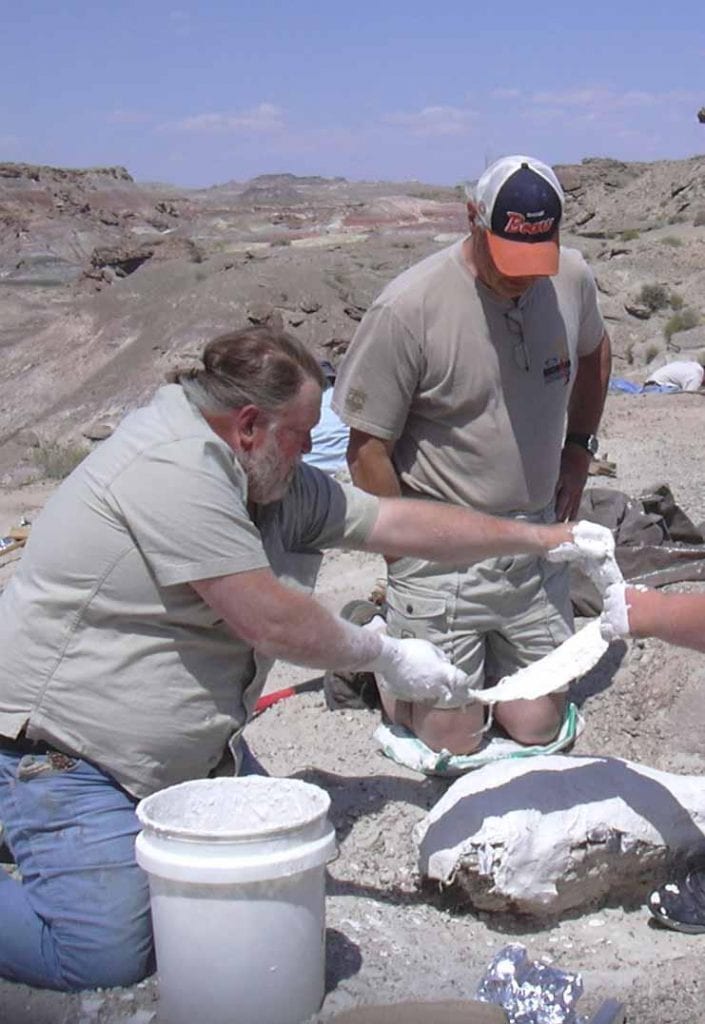
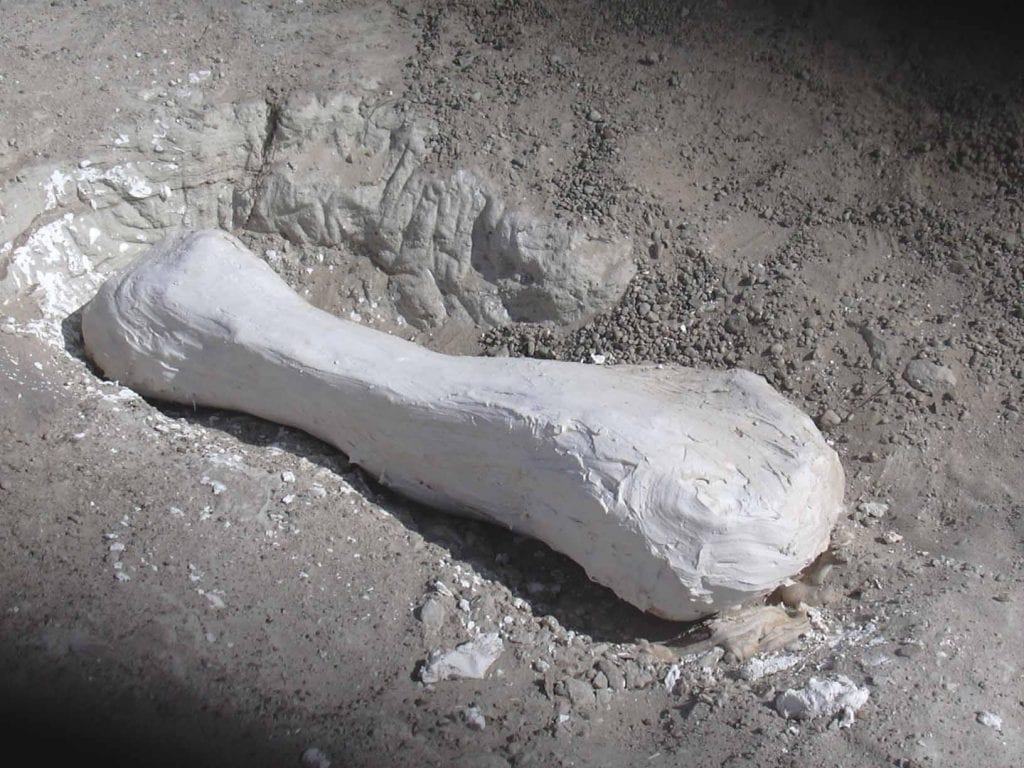
PaleoJoe plastering his humerus
I moved back to the two pubis bones and began to expose them more so they could be jacketed and removed. As I cleaned, following the bone I discovered another
An unbelievably great day
Today was an unbelievably windy day and I would be working on removing the humerus – nearly all day. Part of the work of the paleontologist consists of extremely tedious and sometimes hard work. That was what was about to happen. One end of the humerus was exposed and lay higher in the sediment. It actually lay on a nice bed of pebbles. Ancient pebbles from that fast moving river. As the bone went deeper into the hill, the sediment actually changed to smaller pebbles and finally sand. The sand was compacted first by the river and then by the milenia. Mixed with the sand were other sediments that actually turned it into a concrete as hard as any concrete I have ever seen. This required me to use the small air hammer to remove the sandstone.
Well, finally it was time to leave. I had several commitments I needed to do and sadly left the Cow Dung reservoir. I VOW to return often. This place is rich with dinosaur bones. That need to be excavated. Others will work on my find and no doubt will find more of the skeleton of the camptosaurus that still lies beneath the sandstone cap. When I return the site will look differtly, but bones are bound to be found.
The bones I found were as follows. A tibia, fibula, illium, pubis, humerus, 2 scapulas, a rib, corocoid. Here is a diagram of the bones on a representation of the skeleton of a Camerasaurus.
